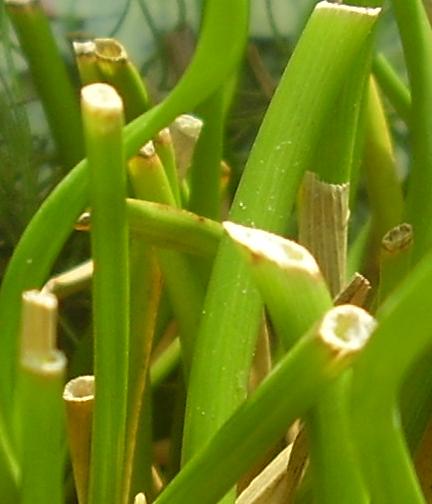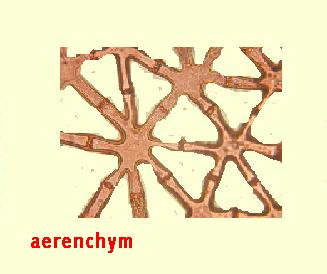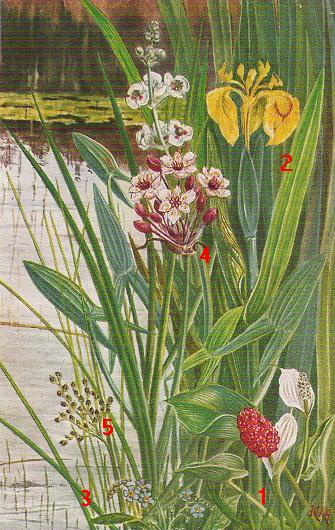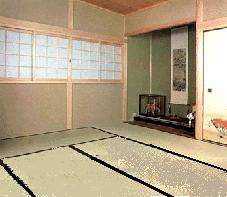
The stem of Soft-rush is filled with a spongy
tissue called aerenchym. This tissue transport oxygen
from the stem to the roots.In this way Soft-rush grows
on anaeroob ( no oxygen) ground, just like Reed and cattail
do

The aerenchym is tissue specialized in transporting
oxygen from the leaves of the roots. The aerenchym
consist of spongy tissue formed bij spaced cells
loosely connected with their neigbour cells. Between these
cells oxygen is transported to the roots. Pitrus is
very sensitiv for brakkish water.probably because the
brakkish water changes the form of the aerenchym, the
oxygen transport stops and the Soft-rush dies.

1: Slangewortel (Calle palustris)
2: Gele lis (Iris pseudacorus )
3: Moeras vergeet-mij-nietje (Myosotis palustris)
4: Zwanebloem (Butomus umbellatus )
5: Pitrus (Juncus effusus)
|
Soft rush
(Juncus effusus)
A very common plant that grows on the border
of ponds but also in fields and gardens Its a very strong plant, that
has the possability to grow on grounds that contain no oxygen at all.
These plants can reach a hight of 1,5meter, and the most important way
of spreading is by forming roots, so in vegetativ way.

Tatami
Soft-rush is used In Japan for the production of Tatami ,
these are mats that cover the floor of Japanese houses.

Tatami all have exactly the same dimensions:
90cmx180cm=1,62 square meter. The lenght of 180 cm is
called a "jo", and the "jo"is the basic of all traditional
Japanese house (Minshuku). Most japanese houses have at least
one room covered with tatami , called the washistu, used as
the room for the tea ceremony.
Tatami absorbs sound and humidity and are soft enough to sit
on for relaxation and meditation,, and are used in martial
art dojo's. In a ryokan, a traditional Japanese Hotel, one
sleeps on a futon (matras) in a room covered with tatami.



Tatami construction
Tatami omote
The upperside consist of 5000 rushes, bind together with a
string of cotton.
Tatami goto
The inside of the Tatami is made of soft rice straw, called wara
Its normal to reuse the wara every ten year by changing the cover.
Tatami goto
On the backside and the sides, cloth is used
as a cover. Total thickness is typical 5,5 cm
Traditional rooms in a Japan house (Minshukus) have all the same dimensions
,and are measured in tatami mats:

Japanese rooms have distinct seizes, in a tea room the tatami has an other
pattern in summertiime and wintertime.
Tearoom : 4 and a half mat
Shop : 5 and a half mat
bedroom : 6 mat
living room(washitsu) : 8 mat
| |

